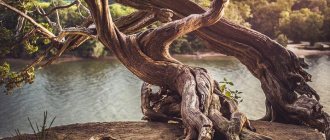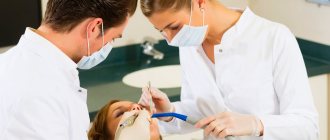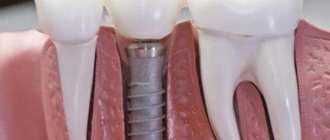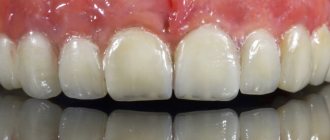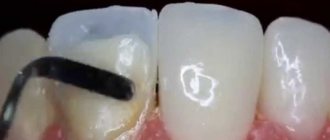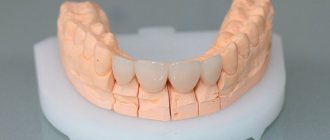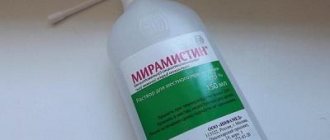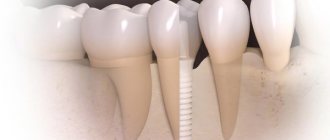Accessory requirements
When you are thinking about buying a brush, you need to think about how well it will meet your requirements and certain criteria. There is a small list of characteristics that any toilet brush must meet.
- The cleaning element must be made of a synthetic material with sufficient rigidity. With its help, it will be much easier to remove dirt.
- The handle is preferably smooth in texture, long enough, and made of durable material. It should be comfortable to hold, but at the same time strong bends are not allowed.
- Preference should be given to collapsible models, since cleaning them in this case will be much easier.
Terms of use
Photo of a designer brush
For some this may seem funny. In principle, you have every right to laugh at the instructions for a toilet accessory. However, you should have a clear understanding of how to use a brush. This will be useful to you yourself, and will also allow you to correctly interpret to your child what this thing is, what it is for, and how to use it correctly.
- The first thing you need to do is grab the handle comfortably and with a firm grip. Do not hold the toilet brush too close to the cleaning head. Actually, almost every model has a specific section of the handle intended for holding by hand.
- Using progressive, gentle movements, begin to remove dirt. You should first dip the brush in water and wet it, after which removal will be easier. In order to simultaneously get rid of excess odors and disinfect the toilet, add a little detergent and cleaner to the toilet.
- Drain the toilet using the flush cistern, while placing a brush under the pressure of the water. This will remove any remaining dirt from it and clean it.
- After rinsing the toilet brush, shake it off a little, after which you can safely put it back in its rightful place.
There are a couple more very useful tips that you should definitely follow and that it is extremely important to teach your children
- When you start cleaning after your business using a toilet brush, do not make any sudden movements. This may result in splashes that fly towards you, onto your clothing, or even onto your skin. We think you shouldn’t imagine what sensations you will experience. Don't take risks, so work the tool smoothly.
- Shake the accessory while it is still inside the toilet by hitting the walls directly next to the water in the plumbing. Many people begin to shake off, hitting the end of the handle on the toilet seat. This causes splashes to fly in different directions, onto the toilet seat itself, onto the toilet lid, onto the wallpaper, and so on.
Storage and care
Interestingly, many people prefer glass and wall-mounted models. However, from the point of view of safety and hygiene, this is the most wrong decision.
But the recommended option is suspended. But even here it is advisable to comply with certain conditions:
- Your toilet brush should not be in contact with the floor;
- The accessory should not come into contact with the wall;
- Be sure to place a container underneath it that is wide enough to allow all the water to drain into it.
Now regarding care. Please note that the toilet brush will have to be washed periodically. The more often this happens, the safer it will be to use. Essentially, there are two proven, effective cleaning methods.
- Dip the cleaning head into any liquid intended for disinfection, thereby getting rid of all kinds of bacteria and infections.
- Wet the toilet brush using white vinegar. Just be careful not to get the liquid on your skin, especially your eyes.
When the disinfection procedure is completed, lower the cleaning head into the toilet, press the water release button, thereby washing the instrument. After this, you can safely put the accessory in place.
It is recommended to hold such events at least once a month. But this is provided that you or your household do not have an intestinal infection. If there are any, then the brush should be cleaned weekly.
As you can see, a brush is far from the simplest accessory for toilets. It has its own characteristics, its own recommendations for use and care.
Despite a number of recommendations for use and selection, you should purchase not only on the basis of safety, so to speak. The modern range of brushes is so huge that all your personal wishes can be combined in one model, and at the same time the tool will fully comply with even the most stringent requirements for hygiene and reliability.
How to choose the right toilet brush
First of all, pay attention to the type of construction. The classic brush can be used on the floor and is stored in a special container-stand.
This traditional option is considered the least hygienic, since the brush is constantly wet and not ventilated, which provokes the development of bacteria.
The wall model is not much different. In this case, the brush is also inserted into a container that is only hung or fixed on the wall. The hanging storage method is considered the most hygienic and suitable. In this case, the brush is hung on a hook, and the water that drains from the brush ends up in a special container. Thus, the product is ventilated and dried.
In addition, today you will find multifunctional models that, for example, combine a brush and toilet paper holder, a container for cleaning products, and so on. They represent a single rack with several holders or containers. This design is perfect for a compact bathroom with little space.
Collapsible models are easier to wash, handle and dry. In addition, if necessary, you can replace only the head, rather than buying a whole new product;
When choosing a material, keep in mind that plastic products often break and do not last long. Therefore, it is better to choose metal brushes. This is a strong and reliable material that will last a long time.
Choose a practical and ergonomic product that is comfortable to hold in your hand. A suitable option would be a handle about 50 centimeters made of durable and smooth material. It should not bend or break much during use. And the brush should be made of hard artificial materials in order to quickly and reliably wash off dirt.
What is it for?
How to use a bidet correctly
As already mentioned, the main purpose of a bidet is to wash the genitals after visiting the toilet. The device simplifies the washing procedure and helps maintain personal hygiene.
It is important that it is much easier and more convenient for people with disabilities, as well as elderly users, to use a bidet rather than toilet paper. The use of a bidet is also indicated to prevent the formation of hemorrhoids.
The bidet is also convenient for washing babies. If there is a shower head, the device is used to clean the bathroom, fill buckets with water, and clean pet trays. If necessary, you can rinse your feet or hands in the bidet, however, provided that the bidet bowl is thoroughly and regularly disinfected.
The main advantage of a bidet is its versatility, practicality, ease of operation and installation. Among the disadvantages is the need to allocate space in the bathroom for the device. However, this disadvantage can be easily mitigated by using a bidet combined with a toilet. The high cost of automatic devices is justified by the comfort and benefits that the operation of the unit brings.
Features of character and lifestyle
Photo: Ruff in Russia
Ruff loves cool water. When the water in a pond becomes too warm, it goes to the mouth of streams or hides under bogs. There he can wait out the whole summer if he lives in a shallow body of water. There lives another one who is not a fan of warm water - the jig, which becomes the main food for the ruffe at this time. If possible, in the summer it can go out of the lakes into the river bed and go there to the next dam, where it then finds the deepest pool in order to wait out the summer at its bottom.
If necessary, the ruffe can also live in places with fast currents. But, like a lot of other bottom-dwelling fish, there he tries to take a liking to some kind of snag, a large stone, a ledge in order to hide behind it and feel comfortable in such a secluded place. In general, ruffes are quite peaceful fish. They get along well with each other within the same population. Even if ruffs of different ages and sizes live in the same place, they do not conflict with each other and do not compete. But at the same time, in the habitat of the ruff population, except for burbot, rarely can anyone get along. Do not forget that ruffs are still predators.
Ruffs usually do not like to change their habitat. In general, they are not characterized by migration. They do this exclusively under compulsion, when the water warms up to a critical level. In this case, the ruffes move to other areas in search of cooler currents. When summer passes and autumn comes, the ruffes begin to actively group, choosing a habitat with a sufficient amount of food. By the way, it is at this time that they become easy prey, so the main catch for ruffs occurs in mid-autumn.
Interesting fact: Larger fish go to the bottom of pools for the winter earlier than young fish.
Early departure to depth is a necessary measure. It happens that strong winds throw ruffs onto land that did not have time to move from shallow water to depth.
Instructions for use
How to use an angle grinder correctly
You should use a bidet after every visit to the toilet. There are no special requirements for use, the main thing is that it is convenient. Most users prefer to sit facing the device, however, this depends on the type of model.
Modern models have several operating modes, including those in accordance with the user’s gender. This allows women and men to wash themselves quickly and comfortably. Some people use toilet paper before washing, while others use a bidet straight away. How to do it right is up to the user to decide. The only thing that doctors recommend is to use soap.
Before using the device, you should check the temperature and water pressure. This will avoid burns and splashing from the water jet. Towels should be placed near the device. From a hygienic safety point of view, these should be disposable towels or napkins. After use, the wipes should not be thrown away in the bidet. Otherwise, clogging of the drain hole cannot be avoided. It is worth placing a special trash can next to the bidet. Many models are equipped with a drying and warm air function, which allows you to avoid using towels.
A bidet is especially necessary for caring for the female genital organs. Regular washing is the best prevention of genital diseases and allows you to maintain their cleanliness during menstruation and after sexual intercourse. As practice shows, it is more convenient for a woman to sit facing the bidet. Men, on the contrary, usually sit with their backs to the bidet. After each use, it is advisable to rinse the bowl using a disinfectant composition.
Tips for storing and caring for a brush
What is a cappuccino maker and how to use it correctly
Based on the above about methods of storing toilet brushes, it is obvious that it is better to keep such an item not in a floor or wall glass, but in a hanging state.
After all, this prevents the accessory from being stored in a humid environment, which is favorable for the development of bacteria and microorganisms in the presence of contaminant residues on the brush.
And when the brush is reused, all these harmful bacteria can get on the human skin or inside the body through the respiratory tract.
Floor or wall brushes with a stand require more frequent replacement.
Therefore, in order to extend the life of the item and achieve more hygienic storage, it is better to give preference to a hanging model.
But here you should know some features:
- Consider where the toilet brush will hang. Please note that it should not touch the walls or floor. Choose the appropriate hook so that the brush dries freely.
- Under it, you must install a wide water catcher (container), which will drain from the brush after use.
In general, no matter what model you choose, you need to periodically wash the entire set. Remember that the more often you do this, the more you will protect yourself and your loved ones from exposure to harmful bacteria.
You need to wash both the bowl in which the brush is stored or where the liquid drains, and the brush itself.
For better disinfection, this can be done using the following means:
Use special chlorine-containing solutions (for example, bleach). At the same time, do not forget to protect yourself from getting bleach on your skin - wear rubber gloves. There is no need to clean for too long so that as little active substances as possible get on the mucous membranes. Such substances quickly remove contaminants without much effort. You can also use acetic acid
The precautions are the same as when using bleach. Alternatively, you can disinfect using the following liquids: boric acid, potassium permanganate, hydrogen peroxide, etc. Some housewives soak the brush in the following mixture: any cleaning agent, half a glass of soda, a quarter glass of vinegar and half a liter of boiling water. Leave the brush in this solution for one hour.
After cleaning the brush with any of the above products, you need to rinse it well with running water in the toilet. Then hang it on a hook to dry. The special water container should also be washed and rinsed well.
You can do this by holding it with gloves over the toilet and pouring water from a ladle, for example. You can dry it with regular toilet paper, the remains of which can then be thrown into the trash. Or leave the bowl to dry separately.
After all procedures, be sure to wash your hands properly, even though you were wearing gloves.
How often should you disinfect your brush?
On average, it is recommended to carry out such cleaning once a week. Possibly less often. But no less than once a month.
If one of your loved ones in the family gets an intestinal infection, then it is advisable to disinfect everything (both the brush and the toilet) every day so as not to spread pathogenic microbes and infect the rest of the family members.
Advice. If there are children in the family and they are already quite independent, then be sure to teach them how to use this necessary accessory. Children must know and observe hygiene measures in the toilet, including when visiting public places.
Whatever toilet brush you choose, floor-standing or hanging, cheap or expensive, the main thing is to properly care for this item so that hygiene in the toilet room is maintained at the proper level.
How to choose a toilet brush and keep it clean
A toilet brush looks like a brush made of artificial bristles, which are shaped like a sphere and are attached to a handle 50–70 cm long. This accessory is used to keep plumbing fixtures clean. It is used both immediately after visiting the toilet and during regular cleaning of the toilet. The brush is sold complete with a special stand, shaped like a bowl, into which it is inserted.
This accessory is an integral attribute of every toilet room; it is impossible to imagine high-quality cleaning of plumbing without its use. A brush is difficult to find in Western countries, where toilets have a slightly different design that does not allow dirt and bacteria to linger on their surface.
The brush allows you to clean the toilet until white without getting your own hands dirty. There are many different models of brushes available in stores, differing in the material from which they are made and functional features.
Brushes that allow you to clean the toilet can be divided into several types.
When planning to purchase a brush to clean the toilet, you should pay attention to a number of important features:
- Ergonomics of the accessory – it should fit comfortably in the hand, the handle should not be too long or, conversely, too short. The accessory should not bend; its handle should have a smooth surface.
- The brush head must be made of artificial material of sufficient rigidity, otherwise it will not be able to perform its main function.
- Special attention is paid to accessories that can be disassembled into parts. This makes it convenient to wash them and disinfect all parts of the structure.
- The style of the brush should be combined with other interior items of the toilet room and not look like an alien element there.
To ensure the hygienic cleanliness of the toilet, it is not enough to flush the water thoroughly; you must clean its surface with a special brush. Proper use allows you to remove not only biological contaminants, but also rust.
A toilet brush can contain several thousand varieties of bacteria and microbes. Not only will it lose its pleasant appearance, the brush will acquire a foreign odor and pose a potential threat to the health of all household members. This is why weekly cleaning of not only the toilet itself, but also the brush is so important.
How can you easily clean a toilet brush without much time or effort?
Simply cleaning the brush using a soap solution will not be enough to remove all bacteria and germs from it.
Therefore, it is important to periodically disinfect this accessory using the following substances:
Whiteness, “Toilet duckling”, “Cilit Bang”, “Domestos” and other cleaning substances containing chlorine. It is imperative to use rubber gloves when working with such products to prevent skin burns. Vinegar essence is an excellent disinfectant.
It is important to keep it out of the reach of children, and when using it, wear protective gloves and try not to inhale its pungent odor. Boric acid, hydrogen peroxide and manganese work well against bacteria. The following composition disinfects a toilet brush well: baking soda, vinegar and boiling water. You need to soak the accessory in this product for 1 hour.
The toilet brush needs to be washed regularly, this is the only way to keep it clean and protect it from the spread of germs. However, improper storage of it can lead to the fact that you will have to wash the entire toilet room, including its walls and floor.
To prevent such a situation from occurring, you need to carefully consider the location of this useful accessory:
it should not touch the surface of the floor and walls; if the brush is hanging, there must be a container under it to collect liquid; the brush should be in close proximity to the toilet so that water does not drip from this accessory onto the floor while it is being carried to the storage location; It is important to explain the rules for using a brush to all family members so that you do not have to organize cleaning of the entire bathroom.
Whatever toilet accessory you choose, it is important to properly organize its storage location and thoroughly and regularly clean it of dirt. In addition, it is important to throw away your old brush every 6 months and purchase a new accessory.
If these rules are followed, the brush will perform its functions well and will not cause health problems.
Manufacturing materials
Let us immediately note that in this section we are talking mainly about the material from which the glass is made.
Plastic
This material is the cheapest. It can have an original shape and a variety of colors. It’s not a shame to throw it away when replacing it. However, plastic products are not particularly durable - they break easily. And besides, they are not always as hygienic as glass or stainless steel.
The unusual plastic toilet brush “Cherry” (made in Thailand) can please the originals. Its round red bulb is shaped like a cherry, the brush handle is green, and the brush head is red. Looks fun and cute. Price – 2 thousand rubles.
And this is not the limit for the wild imagination of designers. For example, plastic pipe cleaners are available in the form:
- plants in pots;
- champagne glasses;
- giraffes;
- machine guns;
- funny cats;
- bowling pins.
Plastic toilet brush Verm-N
Ceramics
Porcelain and earthenware containers look very elegant and luxurious. They have one problem - they fight easily. Therefore, such a brush is suitable only for those who are neat. Similar products are produced by many European manufacturers.
French designers of the brand “Comptoir de Famille” have created a very cute and cozy floor model of a brush called “Angel”. Its container is made in the form of a ceramic jug, decorated with an elegant monogram on the side. The brush handle is metal. Price – 2.8 thousand rubles.
Here's another lovely (but expensive) designer flooring product from the German company. The rectangular, snow-white container is made of porcelain, and the shiny metal handle of the brush is made in the shape of a tree branch. Price – 27 thousand rubles.
Photo of Provence ceramic toilet brush
Bronze and other metals
If you want to add a little antiquity and classics to your decor, you can purchase an elegant toilet brush made of brass, bronze (perhaps even cast iron), decorated with casting, forging or other interesting elements.
- For example, the wall-mounted model of the metal toilet brush “Piglet PI-0731” is equipped with a frosted glass cup held by a funny pig cast from bronze. The product is part of the Piglet collection of designer accessories and costs 5.4 thousand rubles. Note that toilet brushes in the shape of animals are now at the peak of popularity.
- And the wall-mounted model “4411” from the French brand “COMPTOIR de FAMILLE” is very solid and weighty. Its base is cast from cast iron and decorated with intricate curls holding the long handle of a brush. The price of the product is 5.6 thousand rubles.
- Modern bathroom styles often feature an abundance of shiny chrome surfaces. Many brushes are made in this spirit, the containers of which are made of stainless steel. As a rule, they have a strict cylindrical or cubic shape.
- Ikea has many beautiful models made of shiny stainless steel. For example, "Kalkrgund". Its cylindrical glass has a side hole, the head of the brush can be removed and replaced (with a Losnen brush). The handle is also made of stainless steel. Price – 600 rubles.
Metal toilet brush BRONZE Fuente Real
Glass
If it is strong enough (preferably hardened), then this is an excellent option. Neat, beautiful, hygienic. And it suits almost any style.
An example is the wall-mounted model “VTFNRXQ” from the famous. The cylindrical container, reminiscent of a bucket, is made of durable frosted glass and equipped with a plastic lid. The long handle of the brush is made of chrome-plated brass, and its brush is a practical black color. The cover can be fixed on the handle in several positions. Price – 4.9 thousand rubles.
Photo of toilet brush with frosted glass glass C5511
Acrylic
Modern material, increasingly filling our lives. They even make baths from it, which perfectly retain heat. This durable polymer is very flexible and allows you to create beautiful and original products (both in color and shape). This brush is easy to clean and looks modern and stylish.
An example of an acrylic product is the snow-white floor model “Tatkraft Immanuel Olive”, decorated with a beautiful purple pattern (there is also a beige version). Durable, lightweight (only 0.61 kilograms), moisture-resistant vessel with rounded edges also has an antibacterial coating. You can buy this floor-mounted toilet brush for 1.45 thousand rubles.
Finally, we’ll tell you how to clean a toilet brush.
Toilet brush with acrylic glass ART MOON Immanuel Green
Conclusion
I hope that this article helped you decide on the choice of such a seemingly trivial accessory for the bathroom, but in fact it is so important and irreplaceable. Whatever your choice, it is important to remember that toilet hygiene comes first.
Now you will have no doubt that a small and inconspicuous accessory in the restroom is an indispensable device. You have determined the order of its use and how to clean the toilet brush (see also the article “Valve for the cistern - types and methods of repair”).
We suggest you read How to clean cupronickel quickly and effectively
All that remains is to understand the operating rules for other devices and accessories. For more details about this, see the video in this article.
Varieties
A toilet brush is essentially an artificial fiber brush that is attached to a handle about half a meter long. It is usually sold complete with a glass stand.
Today there are many varieties of such products on the market PHOTO: veer.by
If we talk about the classification of such intimate devices, they differ in color, materials of manufacture and method of storage. Let's look at each indicator in detail.
Material
Its quality and strength depend on what material was used to make the brush. A similar parameter is reflected in the cost of the brush. Today you can find products from:
- plastics. There are two types: completely plastic and having a metal rod with a plastic stand. Typically, such brushes are placed on the floor in a special holding device, but you can also find devices without stands. The products are quite cheap, but their strength leaves much to be desired;
- glass Such structures are most often fixed on the wall. The floor-standing version is equipped with metal legs or a stand;
- silicone. This species appeared on the market relatively recently. The advantage of the material is that it does not absorb moisture and does not provoke the growth of pathogenic microflora. Such an accessory, if stored properly, can last for a long time;
- acrylic Made from fairly durable material. Can be found in a variety of colors. In addition, there are transparent specimens that are filled with gel. Careful care is recommended for such products;
- ceramics. This is usually an expensive custom-made product. It is distinguished by its high cost and extraordinary fragility;
- metal (brass, stainless steel). Fits perfectly into a modern interior. This product is easy to use and maintain.
Brushes have long ceased to be just a device for maintaining frequency PHOTO: static-eu.insales.ru
It is necessary to understand that a toilet brush with a plastic or acrylic stand with filler looks out of place in classic interiors, just like a ceramic product in a modern setting.
The more reliable the material, the longer the brush can last. However, this will affect the cost. For example, metal brushes can last much longer than plastic products, but they also cost accordingly.
By storage method
According to the method of placement, brushes are divided into:
- floor. Considered a classic type. It is sometimes called a glass brush, since the toilet brush is placed in a special stand that looks like a glass. It is installed directly on the floor. Despite the popularity of this type, it is considered the least hygienic solution. The container where it is stored has dirty, damp conditions, which is a favorable environment for the growth of pathogenic microflora;
- wall. This type of brush is not too different from a floor brush. Only the stand in this modification is not located on the floor, but is mounted on the wall. The disadvantages of such a brush are the same as those of a floor brush;
- suspension. This storage method is optimal. With this placement option, the brush is hung on a special hook, and the liquid that drains will fall into a glass placed under the brush. This makes it possible to ventilate the device, which does not allow harmful microorganisms to multiply;
- multifunctional. Outwardly it looks like a high stand on which other accessories can be additionally placed, for example, containers with cleaning products.
There can be a great variety of options for placing such a prosaic item as a brush. PHOTO: loomber.ru
How to choose the right toilet for your home
Let's consider which toilet is better to choose. The most important criterion in resolving this issue can be considered the amount of money that the buyer is willing to part with.
The most popular products are in the mid-price category, costing from $150 to $250. These are products from Czech, Polish and Finnish manufacturers, as well as so-called high-quality China.
Floor-standing toilet in the bathroom interior
You should be careful with the budget segment. Often, a cheap toilet ($60–$100) has to be replaced after 2–3 years. However, many domestically produced products, at a relatively affordable cost due to low delivery costs and the absence of customs duties, demonstrate very good quality. This is especially true for products manufactured by us under license.
The most expensive toilets are those made in Sweden, Austria and Germany. Their cost is 300 – 550 dollars, and the quality can be considered ideal.
List of rules for using the toilet
Vladimir Alksandrovich, Nizhny Novgorod asks a question:
Good day! My name is Vladimir Aleksandrovich, I hold the position of head of the technical department of the children's health camp “Solnyshko”. The point is this: during the summer holidays, a large number of children of primary school age from different parts of the country come to our children's health camp and some of them, especially those who live in rural areas, often do not know how to use the toilet correctly. Therefore, the idea came up to hang instructions at the entrances to bathrooms, so as not to explain to each child individually what and how to do. There is absolutely not enough time to come up with instructions, so the question is: are there any generally accepted rules for using the toilet?
There are no single universal rules for using a toilet; there is only a list of recommendations that directly depend on the specific type of toilet installed in a particular toilet, as well as the type of flush control.
The most common types of toilets in our country are:
- Floor-standing with toilet seat.
- Hanging with a toilet seat.
- Chalice of Genoa.
The first type is a regular toilet, located in almost every apartment, attached to the floor with bolts and having a lid and a toilet seat.
The second type is a regular toilet, but it is bolted not to the floor, but to the wall of the toilet and has a seat and a lid.
The Genoa bowl is an unusual anti-vandal toilet, the bowl of which is located at floor level. You need to relieve yourself while sitting on your haunches, like in a rural toilet like a toilet.
There are 2 main types of drain control:
With a push-button control type, liquid is drained from the tank by pressing a button or key into the stock, after which a spring actuates the drain valve.
With the lever type of control, the liquid is drained after squeezing a special lever or pulling the drive cord, which pulls the plug out of the drain hole.
If a regular or wall-hung toilet is installed in the bathroom, the following rules should be observed when using it:
Before sitting on the toilet, you must lower your pants (shorts, leggings, etc.) and panties (tights) to your knees. If a girl is wearing a dress (skirt), then it needs to be pulled up so that its lower edge is at waist level. If the toilet seat cover is lowered, it should be lifted and supported against the drain tank. If the toilet seat is raised, it must be released. It is necessary to sit on the toilet so that your back is facing the cistern, and your legs, slightly bent at the knees, rest lightly on the floor
It is important to spread your legs so that your butt does not fall into the bowl. When performing an act of defecation, it is prohibited to fidget, twist to the sides or jump on the toilet seat. It is strictly forbidden to climb with your feet on the toilet and relieve yourself while squatting, resting your feet on the edges of the bowl. After completing the act of defecation, you need to stand up or raise one hip and wipe yourself with toilet paper. Then the soiled paper should be folded in half and thrown into a special bucket or, if there is none, into the toilet. Finally, you need to stand up, release the lid, press the drain control button all the way and slowly release it
If the flushing system is lever-based, then you need to gently press the lever or smoothly pull out the drive cord as far as it will go and release it after emptying the tank. When passing urine while standing, boys should lift the toilet seat and lid before urinating and release them before flushing.
If a Genoa Bowl is installed in the bathroom, you must follow the following rules:
Before performing natural needs, you should remove all items from your trouser pockets to avoid them falling into the drain hole. Next, you need to lower your trousers and underpants to your knees or pull up your skirt to your waist. After this, you need to squat over the bowl, and it is important that your butt is located directly above the drain hole. During bowel movements, boys should hold the genital organ with their hand so as not to accidentally wet their pants. During the act of defecation, it is strictly forbidden to bend too much backwards or sway to the sides, since due to unnecessary movements you can lose your balance and literally sit in a puddle. After relieving yourself, you should wipe yourself off with toilet paper. Before flushing, you should step aside, otherwise there is a risk of accidentally splashing your clothes.
Regardless of what type of toilet is installed in your toilet, you should remember that this device is not intended for washing feet, watering pets or using it for other household purposes.
Share a useful article:
Appearance and characteristics
Due to the fact that the fish has an expressive appearance, it is very difficult to confuse it with other species. The ruffe has a large head, large pale pink eyes and a mouth with bristle-like teeth. The body of the fish is dense, cylindrical in shape, covered with mucus. There are wide gill covers with spines. There are also small ctenoid-type scales on the surface.
There are gray-green spots and dots on the back. The sides are yellowish. The belly may be light gray or white, depending on environmental conditions. For example, fish that live on a sandy bottom are lighter in color than those that live in areas of reservoirs with a muddy bottom.
The length of an adult individual reaches an average of 10 centimeters. Occasionally there are fish 12 centimeters long. Weight is small - 15-25 grams. But it is quite possible to catch giant specimens, 20 centimeters long and weighing 100 grams.
What is a dental brush for?
People use a baby bottle brush when they need to remove milk residues that could not be removed with regular water. The situation is similar with dental brushes. They are used if necessary:
- remove pieces of food from the interdental spaces that cannot be rinsed with water or removed with a regular toothbrush;
- clean the back surface of the teeth;
- ensure better oral hygiene.
There are a number of medical indications for which it is necessary to use a dental brush:
- wearing braces;
- presence of dental prostheses or implants in the mouth;
- periodontal pathology;
- a large number of diastemas and three;
- crowded teeth and their irregular shape;
- smoking and frequent consumption of coloring products;
- chronic diseases that, even in a vegetative state, have a bad effect on the microflora of the oral cavity.
What do you need to make it easier to use a brush?
First of all, pay attention to the handle. It should be strong, inflexible, not too long, but not short, and fit comfortably in the palm of your hand. If older people will use the brush, you can choose a longer handle so that you don’t have to bend low.
The second point is the head of the brush. As a rule, this is artificial bristles. It should be tough, not thick, but not sparse. A thick one will be difficult to rinse with water, and a sparse or soft one will not be able to properly clean the surface. There are models with double head. One side cleans the toilet bowl itself, and the other its upper side, where water usually flows from.
A very convenient design is a toilet brush with a holder that does not allow the head of the brush to come into contact with the bottom of the glass, and when cleaning plumbing, this holder prevents water from splashing in different directions.
